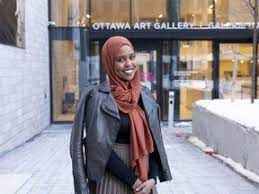|
Ottawa photographer Faisa Omer was thrilled when the
Ottawa Art Gallery bought some of her work to include in
a new exhibition

The arts world's reckoning: How Ottawa's cultural
instituti ons are responding to pressure for more
diversity
As the pressure for change sweeps through the arts
world, the city’s major players are stepping up to
respond to the calls for action — beyond the work that’s
already been taking place to include Indigenous artists.
Lynn Saxberg
Publishing date:
Mar 13, 2021
Photographer
Faisa Omer was starting to get some
recognition for her striking portraits of young men in
her Ritchie Street neighbourhood last summer when she
was invited to tune in to an online focus group for
Black artists hosted by the Ottawa Art Gallery.
The discussion was organized to explore racism in the
arts and it got quite heated, Omer recalls. She waited
until everyone had said their piece before piping up
with a direct question.
“Hey, I want to say something,” she said. “I’m Faisa and
I just did a project about my community. When are you
going to show my photos in your space?”
Dead air. No one had an answer for her on the spot,
though she soon realized they had been listening. About
a month later, she received a message from one of the
gallery’s curators saying they had checked out
Omer’s
work on Instagram and were considering including a few
pieces in an upcoming show.
“I was floored,” says the 29-year-old Somali-Canadian.
“It worked.”
Sure enough, one wall of the gallery’s
new group exhibition, Sheltered in Place: Portraits of
Self, Family and Community, which opened Feb. 20 and
runs until Aug. 15, features several of
Omer’s
portraits of her brother and his friends. Faces of
Ritchie Street also includes quotes from the stories her
subjects told her about their interactions with people
in the city. One example came from a student whose
teacher kept calling him by the wrong name. The excuse?
“That’s because all Black people look the same.”
Back at the Ottawa Art Gallery, the board of directors
passed a resolution last fall that condemns racism and
discrimination, accompanied by a list of action items
that includes a commitment to “forefront work by artists
from marginalized communities.”
For a new artist like
Omer, OAG curators felt she would
benefit from the advice of an established Black artist
and set her up with a mentor, Patrice James, a filmmaker
who’s also executive director of the Independent
Filmmakers Co-operative of Ottawa.
Omer’s journey from her photo studio in the basement of
her family’s townhouse on Ritchie Street, part of Ottawa
Communit y Housing’s Britannia Woods neighbourhood, to
the walls of the Ottawa Art Gallery happened in record
time, thanks to the gallery’s commitment to diversity,
inclusion and systemic change.
Despite their 20-year age difference,
Omer
and James discovered they shared certain
characteristics, starting with an immigrant background.
James’ mother came to Canada from Trinidad, while
Omer’s
parents were refugees from Somalia. Both families
expected their children to do well in school, attend
university and land a secure job, preferably in medicine
or law, not photography or filmmaking.
The oldest of seven children,
Omer
has been able to balance her family’s expectations with
her passion for photography. She has a master’s degree in
neuroscience
and
works as a mental health counsellor for a school
board in Edmonton as she completes
a second
master’s
degree in counselling
psychology.
She also studied
photography
for a few months at Algonquin College.
“I was kind of told to put away my passions because
Somalia is a collective society instead of
individualistic, so everyone has to help the family,”
she explained, adding that she didn’t consider herself a
photographer because she hadn’t finished the Algonquin
course.
SOURCE:
OTTAWA CITIZEN
|